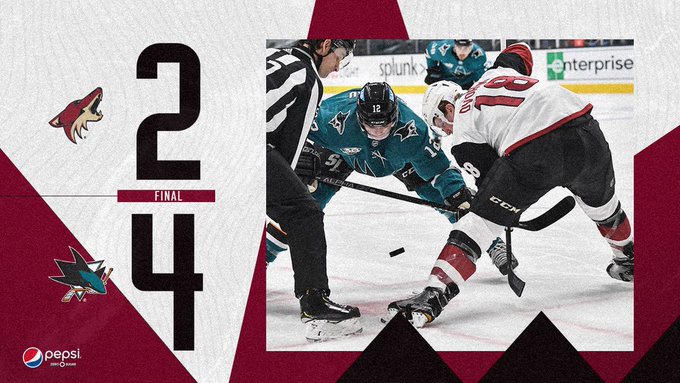The Arizona Coyotes ended the 2020-21 regular season on a high note, with two victories over the San Jose Sharks on Friday and Saturday at the SAP Center, but, unfortunately for the boys in the white sweaters, the pair of triumphs were largely meaningless. Earlier in the week, in what has become a common springtime tradition in the Valley of the Sun, the ‘Yotes suffered postseason elimination as they dropped a 4-2 decision to the visiting Los Angeles Kings on May 5 at Gila River Arena, which was their 12th setback in their previous 15 tries (3-11-1). The defeat also guaranteed that Arizona would finish the year on the outside looking in at the playoff picture for the ninth spring in a row.
The loss, which enabled the St. Louis Blues to ultimately wrap up the West Division’s fourth and final playoff spot, ensured that what was once a promising regular season in Glendale would come to a disappointing conclusion.
Coyotes Fell Apart When Games Mattered the Most
Around a month ago, after a 5-2 win over those same Kings on April 5, the Coyotes sat in fourth place in the West, enjoyed a five-point cushion on their nearest division rivals, and seemed to be a decent bet to return to the playoffs for a second consecutive season. They even looked to be potential buyers at the trade deadline if things continued to go in the right direction.
On April 7, things were still looking good, as the ‘Yotes, winners of six of their previous seven games at the time, held a 3-1 lead on the Kings after 40 minutes at the Staples Center. Then, the house of cards began to collapse, as they allowed LA to score three unanswered third-period goals for a back-breaking 4-3 regulation loss in what was a sign of things to come. From there, the Coyotes were swept at T-Mobile Arena against the Vegas Golden Knights, then dropped games in Colorado and Minnesota to finish a nine-game road trip with a 3-6-0 mark despite starting it with a 3-1-0 record through the first four contests.
Arizona did rebound for a 3-2 win over the Blues on April 17 on Leighton Accardo Day to return to the .500 mark, but they were then swept by the Wild on home ice, which put them at seven losses in their previous eight games. The Coyotes again provided a glimmer of hope for a playoff-starved fanbase with a dominating 4-0 win over LA at the Staples Center on April 24 before heading north to take on the free-falling San Jose Sharks, who were losers of eight in a row entering their two-game set against Arizona on April 26-28.
What looked like an easy four points on paper turned out to be anything but, as the ‘Yotes fell behind 4-0 after less than 24 minutes of play in the first game between the teams on April 26, then found themselves in a 3-0 hole just 14:08 into the rematch on April 28. Two valiant comeback bids were made, as Arizona cut both leads to a single goal in the third period, but they were unable to complete a miracle and left the SAP Center with no points.
The die was essentially cast for the Coyotes after the two losses in Northern California, but they managed to pick up a win and an overtime loss against the first-place Golden Knights to keep themselves afloat a while longer. Things came to a screeching halt once and for all against the Kings, though, who finished what they started back on April 7. The blown 3-1 lead in LA that night was the start of Arizona’s collapse, and the Coyotes’ old Pacific Division rivals were more than happy to put the final nails in the coffin, with back-to-back regulation wins at Gila River Arena to knock the ‘Yotes out of contention.
Despite Disappointment, Coyotes Arguably Met Expectations
This season will ultimately go down as a failure since Arizona did not reach the Stanley Cup playoffs, but, before going any further, let’s be clear – fifth place in the West Division is exactly where many pundits, myself included, predicted the Coyotes would end up in 2020-21. Prior to the season, there seemingly were three clear playoff teams in the West – the Avalanche, Golden Knights, and Blues. There were three clear bottom-feeding teams, too, in the Sharks, Ducks, and Kings. Then, there were the Coyotes and Wild, who many thought would be battling for the No. 4 seed all the way into the season’s last days.
Turns out, we had a few of the teams wrong – the Wild moved ahead of St. Louis in the pecking order, and the Blues were instead the team that beat out Arizona for that fourth spot. Other than that, things proceeded mostly as expected in the West Division, with the three California teams finishing at the bottom, the Avalanche and Golden Knights fighting over first place until the end, and the Blues, Wild, and Coyotes battling for the No. 3 and No. 4 seeds.
Additionally, the fact that the Coyotes were even in the playoff discussion was due more to a lengthy midseason slump by St. Louis rather than anything Arizona was able to accomplish. The Blues endured an injury-plagued 2-8-4 stretch from March 6 to April 5, which allowed the ‘Yotes to hang around longer than they should have. Arizona’s playoff hopes became a possibility thanks to St. Louis’ struggles during this stretch, and they vanished quickly once the Blues regained their form and re-established themselves with an 8-2-3 record from April 7 to May 5.
That the Coyotes remained in playoff contention as long as they did also had a lot to do with the division they’re in. With the 54 points and 19 regulation wins they finished with, Arizona would be in sixth place in the Central, seventh place in the East, and they’d be in a distant fifth in the all-Canadian North Division. The West Division was their best chance at a playoff spot, and they were unable to pull it off due to a few issues which have plagued the franchise for years, as well as a new problem that began in 2020-21. Let’s take a look at the three areas which arguably were the biggest causes for the Coyotes’ elimination:
An Unproductive Power Play
Arizona’s power-play unit has been an issue for quite some time, but it was especially ineffective in 2020-21. Sure, they ended the year with a power-play percentage of 20.8% (their first season above 20% since 2014-15), but the lack of execution during critical moments doomed Arizona. Not only did the Coyotes score few timely power-play goals, but oftentimes they also failed to generate any momentum with the man advantage, or even a shot on goal or scoring chance during a two-minute minor.

Case in point – the Coyotes had three consecutive power plays in Wednesday’s loss to the Kings, but they didn’t manage to generate much offense on any of them, which contributed to their subsequent playoff elimination. Oliver Ekman-Larsson’s 50-footer on goal was the only shot during a Dustin Brown second-period hooking penalty, while Phil Kessel put a 40-footer on net for the only shot during a Sean Walker interference minor late in the period. In the third frame, Andreas Athanasiou was whistled for an illegal check to the head on Conor Garland, who has taken a beating all season long, but the closest of Arizona’s three power-play shots came from 42 feet away.
These long-range shots are almost worthless if there’s no one screening the goaltender in front of the net, and yet the Coyotes continued to fire shots on opposing goalies from above the circles while hoping for something good to happen. With that said, though, it’s hard to fault the players or the coach for the ineffective power-play unit, as there’s a very obvious reason for it, which is…
Lack of Top-End Talent
Defenseman Jakob Chychrun was, without a doubt, the Coyotes’ best player this season. The No. 16 overall pick in 2016, the 23-year-old was second the team in goals with 18 and points with 41, and has a very good chance to lead all NHL defensemen in goals, pending Darnell Nurse’s final three games in Edmonton. Chychrun will probably get a handful of votes for the Norris Trophy, as he should – he had maybe the best season by a blueliner in club history.

However, as good as Chychrun was in 2020-21, the fact that he nearly led the team in goals and points kind of says it all, doesn’t it? The Coyotes have lacked a legitimate top-line forward since their first years in the Valley, when Jeremy Roenick and Keith Tkachuk both enjoyed some outstanding seasons, and this talent deficiency has been one of the main reasons the club has failed to earn a playoff berth in 15 of the past 18 campaigns.
This year, it was more of the same, as, aside from Chychrun, there wasn’t much else in Arizona that jumped off of the page in terms of top-end NHL talent. The only Coyote ahead of him on the scoring list was Phil Kessel, who had a successful bounce-back season with 20 goals and 23 assists. After that, there’s fan-favorite Conor Garland, who fell off a bit in the second half after an outstanding start where he recorded 22 points in his first 23 games, followed by Clayton Keller, who has yet to replicate the same success he found as a rookie in 2017-18.

The wildly inconsistent Nick Schmaltz was fifth on the team in scoring, while Christian Dvorak, who did an admirable job of playing first-line center minutes this season, was sixth. As we get further down the list, we start to see journeymen like Derick Brassard and Johan Larsson, as well as fourth-liners like Christian Fischer, Tyler Pitlick, Dryden Hunt, John Hayden, and others.
There just wasn’t enough talent on this roster this season for the Coyotes to have a realistic chance to compete in the West Division, and the good players they do have were playing in roles they’re unsuited for. We mentioned that Dvorak played first-line minutes this year, but he’d be playing as a No. 2 or No. 3 in an ideal situation. He’s turning into a very nice two-way center, but asking him to play (and win) against No. 1 centermen like Anze Kopitar, Nathan MacKinnon, Ryan O’Reilly, and Jonathan Marchessault every night is a tough ask.

It’ll be even tougher in the Central Division next season, with Mark Scheifele of the Winnipeg Jets along with Joe Pavelski and Tyler Seguin of the Dallas Stars being likely matchups, plus MacKinnon and O’Reilly for Colorado and St. Louis, respectively. Then, there’s Chicago Blackhawks captain Jonathan Toews, who missed the entire 2020-21 season with an undisclosed health issue but reportedly will be back in the lineup in 2021-22.
Until the Coyotes can compete talent-wise with the teams in their division, they’ll always be at a disadvantage more often than not, which underscores the impact the following issue had on their 2020-21 performance:
The Goaltending Couldn’t Carry the Team
Before the season began, it looked like the Coyotes would boast a group of goaltenders that could potentially be among the NHL’s best, which would enable them to remain in playoff contention even with their persistent talent deficiency in the offensive zone. Starter Darcy Kuemper had just completed a dominant 2019-20 season, posting a .928 save percentage in the regular season before carrying Arizona to a qualifying-round upset over the Nashville Predators in the Edmonton playoff bubble. Behind him, backup Antti Raanta had been similarly outstanding, with a .921 SV% through 33 regular-season contests, and third-stringer Adin Hill boasted a .918 mark in limited action.

It was assumed that Kuemper would return to form and continue carrying the Coyotes on his back, while Raanta and Hill would back him up and provide above-average netminding when needed. However, this idea was the furthest thing from what we saw on the ice this year – Kuemper had some nice moments but they simply didn’t happen often enough for Arizona to remain competitive. Darcy posted 11 games with a SV% of .920 or better, but also had 12 stinkers where he stopped less than 90% of the shots he faced. The ‘Yotes were 7-3-1 during the 11 solid performances, but only 4-8-0 when Darcy had an off night in goal.
Raanta also had a tough season. He was plagued by injuries in what has become a yearly tradition in Arizona and wasn’t able to produce during the 12 games in which he saw the ice. His .905 SV% is the worst mark he’s posted as a professional since his rookie year in 2013-14, yet it could be argued that his ineffectiveness stemmed more from the team in front of him than anything else. Of Raanta’s 11 starts, he saw 34 or more shots in 8 of them, including 4 games in which he faced in excess of 40 shots on goal. This isn’t even including his relief appearance against the Avs on March 8, where he stopped all 16 shots he saw in a span of 17:40 after coming in for an injured Kuemper, which would translate to around 54 shots in a 60-minute game.
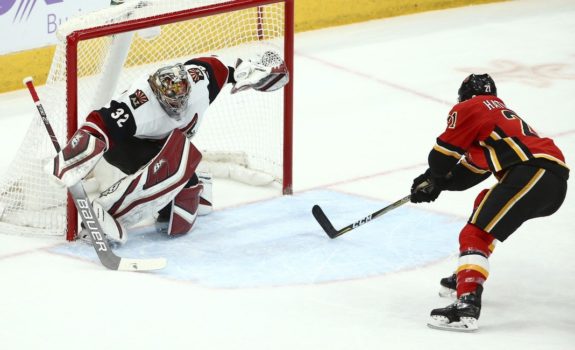
The best goaltender on the roster was Hill, who was on the taxi squad on opening night but was pressed into duty after Raanta and Kuemper both went down with injuries. The 6-foot-6 Hill, taking part in his fourth NHL season, recorded a .913 SV% and a 2.67 GAA in 19 games played this year, 17 of which were starts. He was without a doubt the team’s most effective goaltender, but the combined .906 save percentage from the netminders as a whole wasn’t close to being good enough.
The Coyotes’ year-over-year offensive output remained around the same, dipping only a negligible 0.03 goals per game from last season, but the goals against were up by 0.50 per game, which was the biggest reason for Arizona’s drop from four games above NHL .500 in 2019-20 to two games below that mark in 2020-21.
Arizona Moves on From Tocchet
The late-season collapse, the team’s third such disappointment in the last three seasons, ultimately cost head coach Rick Tocchet his job, as the club announced on Sunday morning that they would be moving on from the fourth-year bench boss.
Tocchet’s tenure in Arizona will likely be looked back upon as a failure, and it’d be hard to argue otherwise when looking at the results. His first year behind the bench in 2017-18 was an absolute disaster from the second the puck dropped, as the Coyotes dropped their first 11 games and won just 12 of their first 53 contests en route to a 29-41-12 finish, which was the worst mark in the Western Conference, and the third-worst mark in the league.
In 2018-19, things went significantly better, as the ‘Yotes found themselves in a playoff position with 10 games left to play, at 36-30-6. Arizona fell apart over those final 10 games, though, losing 7 of them, including a critical road game against the Avalanche on March 29, 2019, which resulted in the club coming up four points short of a playoff berth.
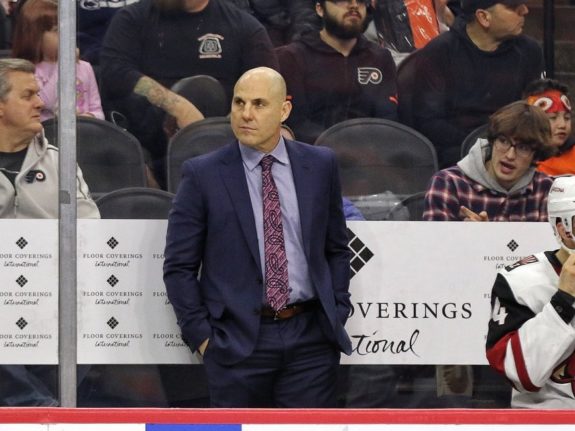
It was more of the same in 2019-20, with the Coyotes getting out to a nice start before faltering down the stretch. They picked up 25 wins in their first 46 games, but went 8-13-4 over the rest of the season to fall into 11th place in the Western Conference, with little hope of climbing back into a wild-card position. COVID-19 caused the regular season to end prematurely, though, and the ‘Yotes unexpectedly reached the Stanley Cup playoffs after the league announced an expansion from 16 teams to 24. Arizona made the most of this opportunity, sending the No. 6-seeded Nashville Predators to an upset defeat in the qualifying round, but the Coyotes themselves were then dispatched in relatively easy fashion by the Avalanche in five games in the opening round.
Tocchet’s record will technically read that the Coyotes reached the playoffs once in his tenure, but they didn’t finish the regular season in a “normal” playoff spot in any of his four seasons, and haven’t done so as an organization since 2011-12. Only the Buffalo Sabres’ drought is longer, at 10 seasons.
With Tocchet gone, there are a lot of names being mentioned as possibilities to replace him, but the one I would keep my eye on is Blues assistant Mike Van Ryn. The 41-year-old is no stranger to the Coyotes’ organization, as he coached the AHL Tucson Roadrunners in 2017-18, which featured players like Garland, Michael Bunting, Lane Pederson, Lawson Crouse, and Hill. Prior to that, Van Ryn served as a player development coach in 2016-17 under then-coach Dave Tippett.
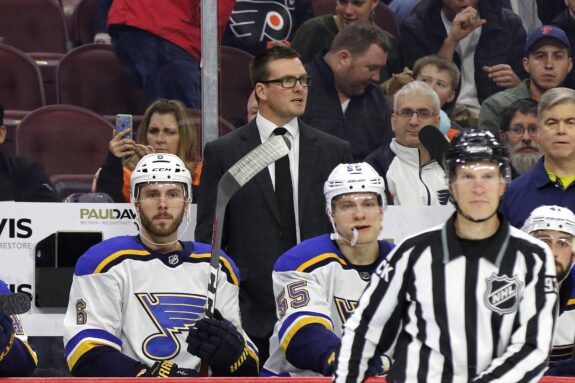
After reaching the second round of the 2018 Calder Cup playoffs in Tucson, Van Ryn moved up to the NHL, where he won the Stanley Cup with the Blues in 2019 as an assistant coach on Craig Berube’s staff. Before he broke into the coaching ranks, the London, ON native enjoyed a lengthy NHL career, playing in 353 games as a right-shot defenseman after being the No. 26 pick in the 1998 draft.
Aside from the fact that Van Ryn already has a degree of familiarity with many players in the Coyotes’ organization, the fact that he also worked alongside general manager Bill Armstrong in St. Louis during a Stanley Cup championship season could only help his cause. Assuming Van Ryn is available and interested, I’d be very surprised if Arizona ends up going in a different direction with this hire.
The Bottom Line
The Coyotes had many weaknesses this year, as most playoff-eliminated teams usually do in the NHL, but the issue that will continue to plague them until rectified is their talent deficiency. I’ve been highly critical of the job that Tocchet has done behind the bench since the 0-10-1 start the club endured in the first month of his tenure in Arizona, and a change behind the bench in 2021-22 will be a welcome sight, but it’s unlikely that any other coach would have been able to get a different outcome from this group this season.
Until the Coyotes are able to match up with their opposition and put similarly-skilled players on the ice, the best they can hope to do is win games by 3-2 scores. It was the team’s formula for success this year, and, when they held the opposition to two or fewer goals, they won often, with a 17-3-2 record. However, when Arizona allowed three or more goals this year, they posted a measly 7-23-4 mark.
We saw a glimpse of the wide talent gap that exists between Arizona and the league’s top teams last August, when the No. 11-seed Coyotes were dismantled in five games by the Avalanche in the Stanley Cup playoffs, but that point was further driven home in 2020-21. In eight games against the Avs this year, Arizona won only twice while picking up one overtime loss. In the process, they were outshot 283-196 and outscored 35-18. Things didn’t go much better against the Golden Knights, as the Coyotes posted the same 2-5-1 mark through eight games while being outshot 240-190 and outscored 23-18.

Against the Wild, the numbers were especially troublesome, with Arizona racking up a brutal 1-7-0 record against their soon-to-be Central Division rivals. The ‘Yotes actually outshot Minnesota in the eight-game series this year, with a 228-222 advantage, but they were outscored by a 32-12 margin nonetheless. This fact further highlights the lack of talent on the roster – when Minnesota got scoring chances against Arizona, they had players capable of making them count. When Arizona had similar opportunities, they were squandered.
These numbers against the top three teams in the West Division really tell the story of the season for the Coyotes. They were able to hang around in the playoff race by picking up a 19-9-4 record against the Blues, Kings, Sharks, and Ducks, but they were woefully outmatched against the division’s three Stanley Cup contenders, as they posted a 5-17-2 mark which ultimately ended the season for Arizona. Had they managed to outlast the Blues and earn that No. 4 seed, it’s likely we’d have been treated to more of the same in a postseason matchup against either Vegas or Colorado. Sure, anything is possible in the Stanley Cup playoffs, but even the most ardent Coyotes fan would have to admit that a first-round series against either of those opponents wouldn’t last much longer than five games.
Next Steps?
For GM Bill Armstrong, he has a busy summer ahead of him. First and foremost, he’ll have to hire a coach, as we discussed previously. When it comes to the roster, he has only three defensemen under contract for 2021-22, with Alex Goligoski, Niklas Hjalmarsson, Jason Demers, and Jordan Oesterle becoming unrestricted free agents in a few months’ time. He also has some decisions to make with young players like Bunting, Pedersen, and Hill, and he’ll surely have a tough contract negotiation on his hands with Garland, a restricted free agent who has been significantly underpaid in the last two seasons.
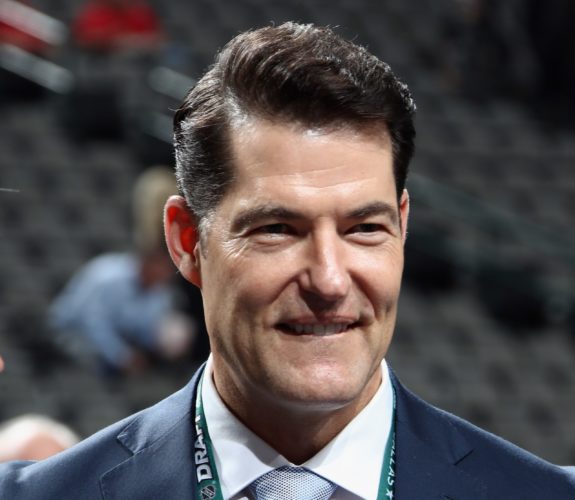
Additionally, there’s the Seattle expansion draft, during which Arizona will likely lose an NHL player this time around after having an AHL player selected by Vegas last time. Then, we have the NHL Entry Draft, where the Coyotes do not have a first-round selection because of the John Chayka-led prospect fitness testing scandal. The club does own two second-round selections, but, with such challenging scouting conditions at the collegiate/junior/international levels due to COVID-19, the depth of the draft class remains to be seen.
Overall, it’ll be another interesting summer for the Coyotes in the Valley of the Sun, as many big decisions will be made. Stay tuned to THW all offseason long to stay updated on the latest!
A lifelong Phoenix resident, Louis has been following hockey since 2010, has covered the Arizona Coyotes since 2015, and has been playing hockey since 2020. So far, Louis has visited eight NHL cities, and one of his personal goals is to eventually make it to all 31 NHL arenas. For any questions or concerns, contact the writer via Twitter @LouisPannone.


